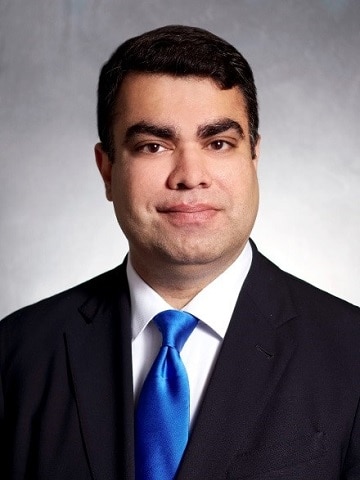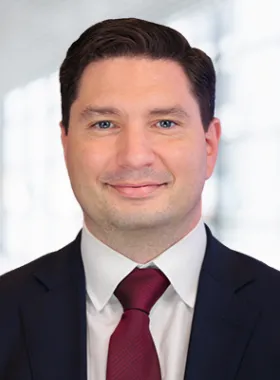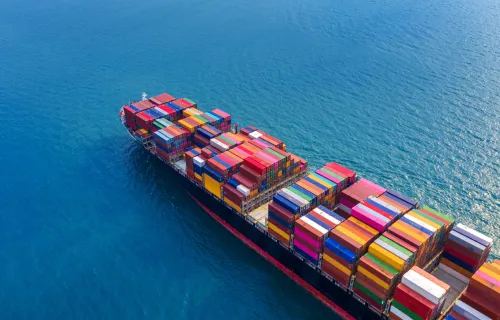In this episode, Patrick DeVilbiss, Senior Offering Manager for Trade and Supply Chain Finance at CGI is joined by Sunil Gupta, Director and Global Trade Product Head at Bank of Montreal (BMO). They discuss how sustainability, emerging technology and supply chain issues are impacting the future of trade finance. BMO is the 8th largest bank in North America by assets, providing personal and commercial banking, wealth management and investment services to more than 12 million customers.
Environmental, social and governance (ESG) is top of mind for both banks and corporate organizations. According to Sunil Gupta, Director and Global Trade Product Head at Bank of Montreal, ESG strategies have shifted from ‘nice-to-have’ to ‘must-have’. Although ESG is here to stay, Gupta expects these strategies to be in a permanent state of development, depending on whether an organization is advanced in their ESG journey, or still moving towards an advanced stage. For example, a bank that has established ESG as a core mandate would be successful in linking ESG to their financial products. They might also have the ability to support clients, structuring deals to help provide incentives to suppliers to gradually improve pricing. A bank with a mature ESG strategy may have a platform that offers clients a transparent end-to-end view of the whole supply chain – from suppliers who are sourcing the product, to the product ingredients, to the final point where it's on the shelf.
When it comes to technology, the biggest client priorities are automation, simplification, optimization, streamlining and centralizing. “What they're looking for is the ability to deliver information and data in an omnichannel manner where they don't have to go to multiple platforms and sources,” Gupta explains. As a result, both the demand and need are building for application programming interfaces (APIs). Clients have specific requests for how they want to be supported. In the cash management and trade sector, for example, the demand for
APIs is driven by large corporates and third parties who want to integrate their technologies into core platforms.
Along with the need for APIs comes the demand for improved service level agreements (SLA), so solutions can be rolled out faster and more efficiently. Added to that, banks like BMO are exploring how to implement various technologies around machine learning and artificial intelligence (AI) for specific use cases in the back office to create efficiencies and speed up process, especially in trade finance. Patrick DeVilbiss, Senior Offering Manager for Trade and Supply Chain Finance at CGI predicts that creating standards in the API space across the banking industry will be of critical importance, with groups like the ICC and Swift driving the shift toward standardization.
Global supply chains have been disrupted by world events, including the pandemic, inflation, high interest rates and the war between Ukraine and Russia. Because of this uncertainty, buyers and suppliers have become resilient over time. Many clients have analyzed their supply chains, they know where the sensitive points are, they've built contingencies around those sensitive points and they've created innovative approaches for dealing with various situations. According to Gupta, the risk-mitigating tactics that organizations are using have advanced over the past two years and as a result, organizations are better able to find support and create contingencies to protect their supply chains.
The pace of change is speeding up in the trade industry, which can lead to a lot of positive advancement. To take advantage of that momentum, Gupta would like to see the trade industry develop an ability to adapt faster, especially when it comes to the entire trade ecosystem. When stakeholders and players focus on becoming more agile and implementing change management strategies more quickly, real progress will be made in the journey toward digitization in the world of trade
- Chapter 1: Introductions
-
Patrick DeVilbiss:
Hello, everyone, and welcome to CGI's latest episode of the ‘What's Happening in Trade’ podcast. I'm Patrick DeVilbiss, Senior Offering Manager for Trade and Supply chain finance. I'm joined, as always, by Nancy Amert, Director of our Trade Innovation Lab. Hi, Nancy. How are you doing?
Nancy Amert:
Hi, Pat. I'm doing great, thanks. Thanks for hosting this, and really excited about our guest speaker today.
Patrick DeVilbiss:
Fantastic, fantastic. We're joined by a good friend of the podcast and the team here at CGI, Sunil Gupta, who is Director and Global Trade Product Head at Bank of Montreal. Hi, Sunil. How are you doing?
Sunil Gupta:
I'm good. How are you doing, Pat? Hi, Nancy.
Patrick DeVilbiss:
Great, thanks.
Nancy Amert:
Hi, Sunil.
- Chapter 2: Where do you think we are in the journey towards sustainability?
-
Patrick DeVilbiss:
So, Sunil, we're really thrilled to have you with us, today. We've got some exciting topics to work through and I'm not going to do much of a preamble. I want to really dig right into it. So, Sunil, let's take our lead off question. We were having some back and forth recently and ESG has kind of become one of the major topics of interest across the trade industry. That's environmental, social and governance for those who may not be familiar with the acronym ESG. But if you go to any conference, read any press release, it feels like it is a top of mind topic in both the banking space, as well as the trade space. Your institution, your bank is a leading sustainability bank and has been, for quite some time. Would you be able to share with us and our listeners here maybe what journey you're on, what you've seen in the ESG space and what BMO has been doing in that area?
Sunil Gupta:
Sure, absolutely, Pat. I think that's an excellent topic to start with. ESG is on top of mind I think not just for banks, also for corporates. I think you hit the question quite well when you say it's a journey. I think that's how we have to look at it. What is important to note is that it has transitioned, I think, a lot from what was previously considered as a ‘nice-to-have’ to a ‘must-have’. It's here to stay, but I do think it's in a permanent state of development and, again, depending on where you are and whether you're a corporate or a bank, the journey is very different. I think, let's look at it that way from a corporate perspective, someone who's really advanced in their journey, what they look like, versus someone who's still maturing. Similarly, from a bank perspective, what does a bank look like that's quite advanced in that journey, versus some bank which is still moving or maturing towards that advanced stage?
What we've seen from a corporate perspective, the more advanced clients that have come across to us, you could feel the characteristics that they bring to the table. They're looking at ESG holistically, so they typically would be looking at all three elements, E, S and G. They would probably be using a technological platform which allows them transparency and provides them data. When they look at their risk management principles, it goes beyond just credit risk for their suppliers. They're actually looking at things which are more specific towards how they're adhering to the ESG principles, and whether they're doing that in-house or through a third party, it varies, but they actually have that data and they're analyzing that data in terms of their suppliers.
Another element, I think the most important one, is that they're actually able to influence their entire supply chain through the ESG principle so it's not just relying on the financial KPIs that they typically would use to assess suppliers. They actually have been able to build into their models ESG criteria as well, and through that, have actually been able to channel it into the pricing perspective and that's how they're actually influencing the entire supply chain. That's more of an advanced client that I would've seen that kind of has all these attributes. A more maturing client probably may not be looking at it holistically, maybe focusing on one element, either E, S or G. They probably would not have a platform but they would be open to looking at a third party and maybe trying to leverage some pay-per-use type platform.
Similarly, even for the risk ratings they may be using a third party who is able to provide them with the required information, as opposed to them individually going deeper into their supplier's practices to determine how they would rate that supplier from an ESG perspective. From an influencing perspective of the supply chain, it's possible that they may not be able to influence the entire supply chain, but maybe one or two suppliers that they're specifically focusing on. That's how that process works with clients. That's how they're slowly moving from a maturing stage to an advanced stage. That's kind of how I see it on the client side. On the bank side, it's a bit different. On the bank side, a bank which has really taken ESG as a core mandate and has advanced that mandate further would typically be able... Firstly, they would have been successful in linking ESG to their financial products.
For us in BMO, for example, we recently launched a program with EDC on guarantees for sustainable finance, wherein up to $60 million EDC would finance half the amount for up to seven years. This is, again, linking an ECL along with trade finance products, or rather, I should say credit shipment trade products, to be able to enable clients who fall within the scope and the parameters. We've got various requirements around the industries. It could be a number of things. It could be bioenergy, it could be agri, it could be carbon trading. There's a number of industries that get covered under this program, and basically what it does is, it provides them with term loans for seven years which they could use towards their business. That's an example of how a bank can link ESG to their financial products.
Another element that an advanced bank you would come across is their ability to actually support clients and how those clients are incentivizing downstream to their suppliers. It's not just about the buyer bearing all the burden. It could be done in a number of ways. If we go even for us specifically at BMO, we've seen a lot of our commodity clients, and especially when it comes to things like structure trade finance, wherein we're able to structure deals along with our clients in providing to the suppliers an incentive and gradually improving the pricing for those incentives. We do share with the client that element of the financial compensation towards the supplier. This again... There's other creative ways also where we're basically... At this stage because where we are in the market, it's a lot of conversation with the client to understand what exactly they want to accomplish and achieve. We try, and we as banks, would try to facilitate that.
The last piece of the element I would say for a bank, which is very important also, is around the platform usage, having an actual platform in itself to be able to offer the clients which will provide them the whole end-to-end view right from start from the... As in the case of our commodity clients, you can see they have their own platforms which basically provides them complete transparency. From the point of view when the suppliers are actually growing the product, to the final point where it's on the shelf space, the whole supply chain, the complete transparency, what's being used, what the product ingredients are, everything is on display and it's very transparent. A lot of that banks are typically looking at third parties to kind of support that, as far as the technology platform goes. We, too, have been assessing and, again, it boils down to your user group, your clients, your own portfolio of where it makes the best sense and where you have the best business case to be able to enable technology to support that.
That's kind of how I see the view from a corporate and a bank perspective. I think there's a lot of challenges still with ESG. I think the momentum is definitely there, it's going to stay, it's going to build up more. I think there is some challenges which will come down the road and is there now as well is around standards and, I think, jurisdictions. You can find in some jurisdictions the mandate has advanced very fast while others it's slower. I think that needs to pick up, and I think there has to be some form of standard across globally when it comes to ESG because I think that's where we'll have a level playing field and it'll be easier to build scale when it comes to supporting our clients for ESG. I'm going to stop there for a minute because I've talked for a bit here.
Patrick DeVilbiss:
You raise some really, really good points and it's interesting to hear the perspective of a corporate and bank journeys and what you're seeing. It sounds like the EDC partnership that you've got is a really interesting one, as well. The notion of standards, I think, is very critical and makes a lot of sense. We've certainly seen certain markets moving faster than others. Europe in particular has been at the forefront on this, but I think we've seen some other regions kind of picking up the pace, as well, so that notion of a global level set would be interesting, and certainly this is not a topic that's going away anytime soon.
- Chapter 3: What emerging technology is helping you better serve your corporate customers?
-
Patrick DeVilbiss:
Let me shift directions just a little bit, Sunil. Let's talk about emerging technology trends and technology, generally. You all as a bank, I think, are always looking at cutting edge solutions, what you can deploy to make your customer journey better, what you can deploy to increase your own operational efficiency. What are you seeing today that you're implementing or looking at implementing that's going to be able to help enable your corporate customers? How are you kind of seeing that play out, if you can give some details there?
Sunil Gupta:
Sure. I mean, there's a lot to talk to when it comes to emerging technologies because there's so much out there. I will, though, limit it to two key areas that I think are most relevant to us, and, again, this is based on what we are hearing from our clients, the feedback we get, what we're seeing from them. The biggest, I think, right now where clients are really coming to us is... It's a big push towards automation, simplification, optimizing, streamlining, centralizing. They're coming to us because what they're looking for is the ability for us to deliver information, data to them and what I could say probably in an omnichannel manner where they don't have to go to multiple platforms, multiple sources. They should be able to have that delivered to them, and this is where we're seeing a huge transformation in how we look at data.
I mean, for me it almost... It's come to the point where I think you have to start treating data as a product itself, just like you would any other trade finance product and that's, I think, how you can of move the needle. For us specifically, where this is proving to be relevant around the emerging technology space is around APIs. There's a lot of work being done at our bank both from an enterprise level and as well as from the trade finance level. We do have specific use cases scenarios where clients are coming to us and asking us around APIs. It is moving very fast. I think about six months ago or 10 months ago it was more just a question of broaching the topic with our clients and the client just asking us what information we could provide them on APIs. Now they're coming with specific requests and that's starting to pick up. The demand is building and the need is building on how they actually want us to support them when it comes to the API space.
On the cash management side, we've seen where banks moved very fast, and on the APIs it's advancing really, really quickly because the client need has... The demand is so significant there. On the trade space, I would say it is a little bit more reactive but the need is there and the demand is there and it's stemming from large corporates. That's kind of an area or a focus that we're looking at, and it's not just on the corporate side. We are also looking from the trade perspective, as well as where third parties are concerned. We've been working with CGI, and CGI, I think, also is working downstream with other vendors as well in terms of how they can integrate their technologies into the core platform using APIs. I think that's the number one focus right now. Another thing that clients are really asking from us, and it's always a never-ending demand, it's around improved SLAs and basically how we can make things faster for them, how we can improve efficiency.
That's where kind of we've started down... Again, this is another journey around machine learning and AI and working with CGI, working with other partner banks and third party content. We're at the point where we're looking to implement various technologies around machine learning and AI for specific use cases in our back office. What that will enable, eventually for us, is to be able to create more efficiencies and speed up the process. Now, with machine learning and AI what I have seen and what I've heard in the marketplace is that it is proven, it works quite well. It's just, it's a very long journey. It takes time, but once effective it's not just only looking at efficiencies, it's also around risk management and it's supporting the bank's risk management and compliance needs in a more automated way, as opposed to just the manual processes that are there.
I think this is an area which, down the road, is really going to have a great impact on trade finance, is around the whole machine learning and AI. I think it's going to be a question for each bank of how they implement it and the focus they provide it. Till now, I think as far as trade finance goes a lot of the banks... It's been more reactive as part of an enterprise-wide initiative and trade finance is kind of the spillover for that machine learning, AI piece, but where banks specifically focus in the trade space and are ready to make the commitment towards the investment for machine learning and AI, this is going to have great, great improvement in their processes down the road. That's kind of the two emerging technologies that I would say are really a focus on, is around APIs and machine learning.
Patrick DeVilbiss:
Yeah, yeah. I think we should call this ‘The Journey Podcast’ for today because there's that word journey again on the ML and AI side and what you're looking at it. I think there's some interesting work that's going on in that space, particularly in the digital document and data capture area, which I think is extremely impactful and will have a profound impact, as you said, to your customer base and also potentially to your own internal ops risk management, which is extremely critical. The other items that you touched on, I think we hear echoed in the industry over and over again, more of an API-based approach and omnichannel considerations to reduce the touchpoints for your corporate customers. I think we've heard those sentiments repeatedly.
On the API side, the one thing... I'll say my piece and then we'll move to the next question, but the API discussion goes back to some of that standard conversation you also had on ESG. The APIs—as corporate customers come to banks and request more and more consideration for APIs. You can build a lot of bespoke work, but ultimately that becomes unmanageable and unwieldy in terms of you being able to maintain that long term. So, one of the areas that we, certainly on the CGI side, see as of critical importance is going to be standards in the API space across the industry, which we have seen initiatives by groups like the ICC and Swift and others kind of stepping into that fold. It will be very fascinating to see over the next six to 12 months how some of that evolves because that discussion is coming hot and fast right now.
Sunil Gupta:
I'll just make one comment there. I think you're correct on the journey point, and I think the reason for that is because over the years trade has been so resistant towards change and over the last, I'd say three to five years, the change process has sped up considerably. But a lot of the change which happens in trade which is transformational always requires a journey. I think that's why where we are today placed, we're having a lot of these themes around journey, is because of the fact that it does take that whole... It takes that whole effort and time in order for trade to feel the impact of whether it be emerging technologies or whether it be ESG. It's just how trade is positioned.
Patrick DeVilbiss:
No, absolutely, absolutely. I'd be fascinated to see a study of pre-pandemic and post-pandemic just the number of doc examinations that were being done on physical docs versus digital docs at the end. When I say digital, I mean at least just PDF scanned and being reviewed on a screen because I feel like even in the last three to five years we've seen some really big shifts and a willingness to modernize, but certainly the business is... It has been around for a very long time and is somewhat resistant to change, if you will.
- Chapter 4: How are you helping customers address supply chain backlog challenges?
-
Patrick DeVilbiss:
Let's shift topics again a little bit and let's talk about what's happening... I don't want to quite say at a macroeconomic level, but maybe a bit more tangibly for us in terms of supply chains. We know that there have been a ton of backlogs in supply chain, there have been a lot of challenges that have been out there at different points during the pandemic. We've seen certain goods suddenly become unavailable for whatever reason, and certainly with what's happening in Ukraine at the moment that has not made our world easier. What are you seeing in terms of the supply chain backlog and how is your institution maybe looking to help support your customers in addressing those challenges and issues?
Sunil Gupta:
The last few years have been very, very interesting. As we hear our clients talking, it's... In a way, I'm quite impressed at how advanced they are when it comes to risk management and also how well they are now... Compared to what they were two years ago, how well they are now when it comes to various disruptions. When the pandemic hit in, I think at that point clients were a little... They weren't so well-prepared. I think no one was. There was a lot of scrambling, a lot of push towards automation and customers were looking for guidance, basically, direction on how do they approach it. But what has happened over, I think the last two years, I think it's built a lot of... If I could say buyer, supplier resilience and the ability to maintain supply chain stability because that's no longer... I think maybe I mentioned this before also to you at one point, that a stable supply chain is no longer a given.
I think, when it comes to things that are happening around us, and you've mentioned a few like there's COVID, inflation, high interest rates, the war with Ukraine and Russia, there's so much happening that I think the buyers and suppliers have developed this resilience. They've been able to become more sustainable through these disruptions, and that's kind of where, currently, where we see the clients are focused on. Before when it came to clients coming and looking for direction, they're coming with what their needs and requirements are and we're basically supporting them in that. It's a lot of conversation happening, and most of the time what happens when it comes to something like supply chain, they've fully analyzed their particular supply chain, they know where the sensitive points are, they've built contingencies around those sensitive points and they've also come up with various innovative approaches towards dealing with various situations.
A lot of the times it does stem from, "Okay, if you've got a key supplier and there's a risk that that supplier... The goods may not be able to come or that supplier's going to have certain issues," there's a couple of options they can do. If it's something that's solvable, then it's very easy, but if it's something —the buyer will work with the supplier to make it happen—but where it's a question, where it's outside their control, then buyers are typically looking at alternate suppliers for those key pieces. What happens when they look at alternate suppliers, though, is that it's going to come at a higher cost because where they've established a relationship with the supplier, the pricing has been adjusted that way. Now, coming to a new supplier, the cost is going up.
I think that's where we're playing a key role, is that how we're supporting the supplier while they're looking to manage their physical supply chain risk, how we're supporting it through the financial supply chain. Whether it is in the form of the products we offer, or whether it is in the form of the existing products we offer, how we can create more efficiencies for them through that. That's kind of where we are right now with where I see where our clients are right now. They're risk mitigating tactics that they're using and the approaches they're using, they're far advanced than what they were two years ago and they have a better handle on it in terms of how to create and how look for backup, look for contingencies, look for support just to make sure that they protect their supply chain. That's kind of what we're seeing from the customers.
Patrick DeVilbiss:
Yeah, that makes sense. Very fascinating. We're certainly cursed to live in interesting times, unfortunately, but it sounds like your customers are resilient, which is really good to hear.
- Chapter 5: Rapid fire questions
-
Patrick DeVilbiss:
So, Sunil, we're coming up to the end of our time. I've got a few rapid-fire questions that I want to shift us over to so, we'll try to knock these out quickly. Question number one, favorite book, movie or sports team or any alternative of that, if you'd prefer?
Sunil Gupta:
Yeah. I'll actually give you for all of that. The movie... I'm going to date myself with this movie, Die Hard. Favorite book... it's funny because I'm not much of a reader, but where I know a book has been made into a movie, I definitely, definitely would look at that. I think my all-time favorite would be... It's an old one, two thousand... I think it was in 2006, The Pursuit of Happiness. This was on Chris Gardner. When I saw the movie, it was quite interesting. When I read the book, it was quite different. That's on the book side, and I think the favorite team, I have to go with Toronto Maple Leafs.
Patrick DeVilbiss:
That's a good one. I will say, Die Hard absolutely best, I believe, Christmas movie out there. Everyone knows that. Next question, then. And some good responses there, Sunil. Next question, if you consider the future of trade, do you see that as being an Android experience or an Apple experience? You interpret that however you'd like to.
Sunil Gupta:
It's very interesting. I'm going to go... I'm an Apple user so I've got all... Right from... I've still got an... you're going to laugh at this. I've got the early iPhones. I've got an iPhone 3 and 4 and it works. I just have to plug it in because the battery's shot, but I've got all the Apple gadgets you can think of. Our house is an Apple house. I would say, and so I'm going to use that as my basis, but I would say yeah, I think it'll follow... Again, back to our journey concept. It's going to follow the Apple journey. There was a lot of evolution that came and I think Apple did a lot in terms of moving with the times, working with their clients and kind of bringing in new applications, bringing in new ideas on how to make life better for the clients.
I think with trade, it's the same journey. I mean, that's been the theme of this podcast. It's that we're going through a journey. I think that's where we have to be appreciative and understand that it is going to take time, but the important thing is that I think everyone in the trade space, in the trade ecosystem, they're all committed to moving the needle and moving trade forward as part of this journey, whether it be in the form of automation, whether it be in the form of strategically integrating it with other lines of businesses, whether it be regulatory. Everyone on that pace is moving in that journey. I'm going to stop there because I know we're running low on time.
Patrick DeVilbiss:
No, that's a very good answer, Sunil. Last question over to you, if you had a magic wand and you could kind of get us to the end of the journey and the trade experience, what is it that you would change about trade today, if you could wake up tomorrow and have one thing be completely different, or be as futuristic as you want it to be? Is there one thing you would change in the trade space?
Sunil Gupta:
I think the only thing I would... Really, I think what we should be changing in the trade space is the concept of change management. I mean, a lot of what we're doing today is not new. I've been around I think a good 25, 30 years in trade and all this was talked about 25 years ago as well. The only thing was that that whole change management process never took shape till now, and now the pace is picking up but I think if I were to change... I really wish we had a faster ability to adapt, especially around the whole trade ecosystem. I think there's a lot of great things happening, there's a lot of advancement taking place and when it comes to trade that's the one thing I think where all the stakeholders and the players... I think they really need to focus more on is how to be more agile, implement that change management faster. That's kind of what I would like to see.
Patrick DeVilbiss:
That's a very good answer and certainly would be impactful. Concepts being around for 20, 30 years I feel like is not uncommon but it's great that we're starting to see some of that advancement and some real change in digitization take place in the world of trade. On that note, Sunil, we really appreciate you taking the time to meet with us today. Really good session. Thank you so much for joining, and looking forward to talking with you again in the future.
Sunil Gupta:
Thank you. Thank you so much for having me. I really enjoyed it.
Patrick DeVilbiss:
Absolutely, absolutely. Nancy, thanks again, as always. To you, the listener, we will see you on the next ‘What's Happening in Trade’ podcast.






